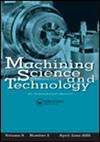采用热强化车削技术对硬化AISI630不锈钢进行可持续加工
IF 2.6
4区 工程技术
Q2 ENGINEERING, MANUFACTURING
引用次数: 2
摘要
摘要本研究的主要目的是首先模拟硬化AISI630不锈钢的切削过程,以实现热强化车削,然后进行热车削(HT)实验,以证明该工艺的有效性,并确定能够在可持续性方面产生最佳结果的切削参数。为了准确预测切屑形态以及切削力和刀具温度,2 D和3 分别使用AdvantEdge软件进行了三维有限元分析。数值分析表明,HT在300 °C可使切削力降低28%。与传统车削(CT)相比,HT中的刀具磨损减少了33%。此外,应用数值分析和实验数据研究了切削力波动与加工表面粗糙度之间的关系。结果显示,在300 °C可将机加工表面粗糙度降低23%。此外,已经观察到,与CT相比,HT技术减少了侧流和表面损伤。本文章由计算机程序翻译,如有差异,请以英文原文为准。
Sustainable machining of hardened AISI630 stainless steel using thermally enhanced turning technique
Abstract The main objective of this study is to initially simulate the cutting process of hardened AISI630 stainless steel to implement thermally enhanced turning followed by hot turning (HT) experiments to demonstrate the effectiveness of the process and identify cutting parameters that would yield the optimum results in terms of sustainability. To precisely predict the chip morphology, as well as the cutting force and tool temperature, 2 D and 3 D FEM analysis, have been used, respectively using AdvantEdge software. The numerical analysis showed that HT in 300 °C causes a reduction of 28% in cutting forces. The tool wear in HT reduces up to 33% in comparison to conventional turning (CT). Furthermore, the relation between cutting force fluctuation and the machined surface roughness has been investigated applying numerical analysis and experimental data. The results revealed that HT in 300 °C reduces the machined surface roughness up to 23%. In addition, it has been observed that HT technique decreases side flow and surface damages in comparison to CT.
求助全文
通过发布文献求助,成功后即可免费获取论文全文。
去求助
来源期刊

Machining Science and Technology
工程技术-材料科学:综合
CiteScore
5.70
自引率
3.70%
发文量
18
审稿时长
6 months
期刊介绍:
Machining Science and Technology publishes original scientific and technical papers and review articles on topics related to traditional and nontraditional machining processes performed on all materials—metals and advanced alloys, polymers, ceramics, composites, and biomaterials.
Topics covered include:
-machining performance of all materials, including lightweight materials-
coated and special cutting tools: design and machining performance evaluation-
predictive models for machining performance and optimization, including machining dynamics-
measurement and analysis of machined surfaces-
sustainable machining: dry, near-dry, or Minimum Quantity Lubrication (MQL) and cryogenic machining processes
precision and micro/nano machining-
design and implementation of in-process sensors for monitoring and control of machining performance-
surface integrity in machining processes, including detection and characterization of machining damage-
new and advanced abrasive machining processes: design and performance analysis-
cutting fluids and special coolants/lubricants-
nontraditional and hybrid machining processes, including EDM, ECM, laser and plasma-assisted machining, waterjet and abrasive waterjet machining
 求助内容:
求助内容: 应助结果提醒方式:
应助结果提醒方式:


